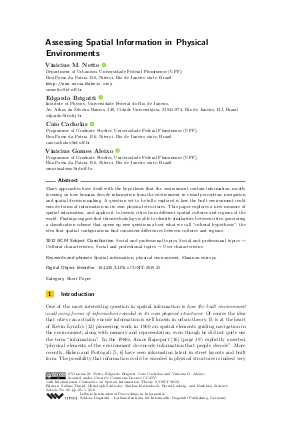Assessing Spatial Information in Physical Environments (Short Paper)
Authors
Vinicius M. Netto  ,
Edgardo Brigatti
,
Edgardo Brigatti  ,
Caio Cacholas
,
Caio Cacholas  ,
Vinicius Gomes Aleixo
,
Vinicius Gomes Aleixo 
-
Part of:
Volume:
14th International Conference on Spatial Information Theory (COSIT 2019)
Part of: Series: Leibniz International Proceedings in Informatics (LIPIcs)
Part of: Conference: Conference on Spatial Information Theory (COSIT) - License:
 Creative Commons Attribution 3.0 Unported license
Creative Commons Attribution 3.0 Unported license
- Publication Date: 2019-09-03
File

PDF
LIPIcs.COSIT.2019.25.pdf
- Filesize: 11.09 MB
- 8 pages
Document Identifiers
Subject Classification
ACM Subject Classification
- Social and professional topics
- Social and professional topics → Cultural characteristics
- Social and professional topics → User characteristics
Keywords
- Spatial information
- physical environment
- Shannon entropy
Metrics
- Access Statistics
-
Total Accesses (updated on a weekly basis)
0PDF Downloads0Metadata Views
Abstract
Many approaches have dealt with the hypothesis that the environment contain information, mostly focusing on how humans decode information from the environment in visual perception, navigation, and spatial decision-making. A question yet to be fully explored is how the built environment could encode forms of information in its own physical structures. This paper explores a new measure of spatial information, and applies it to twenty cities from different spatial cultures and regions of the world. Findings suggest that this methodology is able to identify similarities between cities, generating a classification scheme that opens up new questions about what we call "cultural hypothesis": the idea that spatial configurations find consistent differences between cultures and regions.
Cite As Get BibTex
Vinicius M. Netto, Edgardo Brigatti, Caio Cacholas, and Vinicius Gomes Aleixo. Assessing Spatial Information in Physical Environments (Short Paper). In 14th International Conference on Spatial Information Theory (COSIT 2019). Leibniz International Proceedings in Informatics (LIPIcs), Volume 142, pp. 25:1-25:8, Schloss Dagstuhl – Leibniz-Zentrum für Informatik (2019)
https://doi.org/10.4230/LIPIcs.COSIT.2019.25
BibTex
@InProceedings{netto_et_al:LIPIcs.COSIT.2019.25,
author = {Netto, Vinicius M. and Brigatti, Edgardo and Cacholas, Caio and Aleixo, Vinicius Gomes},
title = {{Assessing Spatial Information in Physical Environments}},
booktitle = {14th International Conference on Spatial Information Theory (COSIT 2019)},
pages = {25:1--25:8},
series = {Leibniz International Proceedings in Informatics (LIPIcs)},
ISBN = {978-3-95977-115-3},
ISSN = {1868-8969},
year = {2019},
volume = {142},
editor = {Timpf, Sabine and Schlieder, Christoph and Kattenbeck, Markus and Ludwig, Bernd and Stewart, Kathleen},
publisher = {Schloss Dagstuhl -- Leibniz-Zentrum f{\"u}r Informatik},
address = {Dagstuhl, Germany},
URL = {https://drops.dagstuhl.de/entities/document/10.4230/LIPIcs.COSIT.2019.25},
URN = {urn:nbn:de:0030-drops-111179},
doi = {10.4230/LIPIcs.COSIT.2019.25},
annote = {Keywords: Spatial information, physical environment, Shannon entropy}
}
Author Details
- Department of Urbanism, Universidade Federal Fluminense (UFF), Rua Passo da Patria 156, Niteroi, Rio de Janeiro state, Brazil
- Institute of Physics, Universidade Federal do Rio de Janeiro, Av. Athos da Silveira Ramos, 149, Cidade Universitaria, 21941-972, Rio de Janeiro, RJ, Brazil
- Programme of Graduate Studies, Universidade Federal Fluminense (UFF), Rua Passo da Patria 156, Niteroi, Rio de Janeiro state, Brazil
References
-
Geoff Boeing. Urban spatial order: street network orientation, configuration, and entropy. SSRN Electronic Journal, 2018.

-
Valério Augusto Soares de Medeiros. Urbis Brasiliae. O Labirinto das Cidades Brasileiras. Editora UnB, 2013.

-
David P Feldman and James P Crutchfield. Structural information in two-dimensional patterns: Entropy convergence and excess entropy. Physical Review E, 67(5):051104, 2003.

-
Simone Garlandini and Sara Irina Fabrikant. Evaluating the effectiveness and efficiency of visual variables for geographic information visualization. In International Conference on Spatial Information Theory, volume 5756, pages 195-211. Springer, 2009.

-
Herman Haken and Juval Portugali. The face of the city is its information. Journal of Environmental Psychology, 23(4):385-408, 2003.

-
Hermann Haken and Juval Portugali. Information adaptation: the interplay between shannon information and semantic information in cognition. Springer, 2014.

-
B Hillier. Space is the machine. Cambridge University Press, 1996.

-
Bill Hillier. The genetic code for cities: is it simpler than we think? In J. Portugali, H. Meyer, E Stolk, and E. Tan, editors, Complexity theories of cities have come of age, pages 129-152. Springer, 2012.

-
Didier G Leibovici. Defining spatial entropy from multivariate distributions of co-occurrences. In International Conference on Spatial Information Theory, pages 392-404. Springer, 2009.

-
Annick Lesne, Jean-Luc Blanc, and Laurent Pezard. Entropy estimation of very short symbolic sequences. Physical Review E, 79(4):046208, 2009.

-
R. Louf and M. Barthelemy. A typology of street patterns. Journal of The Royal Society Interface, 11(101):20140924, 2014.

-
Kevin Lynch. The image of the city, volume 11. MIT press, 1960.

-
Vinicius Netto, Edgardo Brigatti, João Meirelles, Fabiano Ribeiro, Bruno Pace, Caio Cacholas, and Patricia Sanches. Cities, from information to interaction. Entropy, 20(11):834, 2018.

-
Vinicius M Netto, Joao Meirelles, and Fabiano L Ribeiro. Social interaction and the city: the effect of space on the reduction of entropy. Complexity, 2017, 2017.

-
Juval Portugali. Complexity, cognition and the city. Springer Science & Business Media, 2011.

-
A. Rapoport. The Meaning of the Built Environment. Sage, 1982.

-
Mahbub Rashid. The Geometry of Urban Layouts. ArchéoSciences / Journal of Archaeometry, 2017.

-
Ruth Rosenholtz, Yuanzhen Li, and Lisa Nakano. Measuring visual clutter. Journal of vision, 7(2):1-22, 2007.

-
Thomas Schürmann and Peter Grassberger. Entropy estimation of symbol sequences. Chaos: An Interdisciplinary Journal of Nonlinear Science, 6(3):414-427, 1996.

-
Claude E Shannon. A Mathematical Theory of Communication. Bell system technical journal, 27:379, 1948.

-
Claude E Shannon. A Mathematical Theory of Communication. Bell system technical journal, 27:623, 1948.

-
Wilson P Tanner Jr and John A Swets. A decision-making theory of visual detection. Psychological review, 61(6):401-409, 1954.

-
Allison Woodruff, James Landay, and Michael Stonebraker. Constant information density in zoomable interfaces. In Proceedings of the working conference on Advanced visual interfaces, pages 57-65. ACM, 1998.

-
W. H. Zurek. Complexity, Entropy and Physics of Information. Addison-Wesley, Redwood City, CA, 1990.

